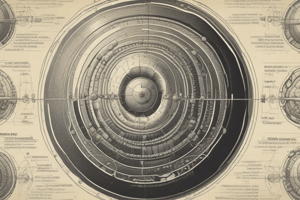Podcast
Questions and Answers
Which of the following nerves is responsible for sensation in the skin of the upper lip?
Which of the following nerves is responsible for sensation in the skin of the upper lip?
- Infraorbital nerve (correct)
- Supratrochlear nerve
- Zygomaticofacial nerve
- Mental nerve
Which of the following is NOT a branch of the mandibular nerve (CN V3)?
Which of the following is NOT a branch of the mandibular nerve (CN V3)?
- Buccal nerve
- Auriculotemporal nerve
- Zygomaticotemporal nerve (correct)
- Mental nerve
Which structures are innervated by the branches of the trigeminal nerve?
Which structures are innervated by the branches of the trigeminal nerve?
- Skin of the face, mouth, and tongue
- Muscles of mastication, mylohyoid, and anterior belly of the digastric
- Sensory of the nose, teeth, and paranasal sinuses
- All of the above (correct)
What is the typical presentation of lesions affecting the trigeminal nerve?
What is the typical presentation of lesions affecting the trigeminal nerve?
Which of the following is a potential cause of trigeminal neuralgia?
Which of the following is a potential cause of trigeminal neuralgia?
Which muscle is responsible for compressing the nostrils?
Which muscle is responsible for compressing the nostrils?
Which nerve is responsible for the motor innervation of the muscles of facial expression?
Which nerve is responsible for the motor innervation of the muscles of facial expression?
Which of the following muscles is NOT a muscle of mastication?
Which of the following muscles is NOT a muscle of mastication?
What is the primary function of the Buccinator muscle?
What is the primary function of the Buccinator muscle?
Which of the following muscles is primarily responsible for raising the upper lip?
Which of the following muscles is primarily responsible for raising the upper lip?
Bell's palsy is a condition that affects which nerve?
Bell's palsy is a condition that affects which nerve?
Which of the following is a symptom of Bell's palsy?
Which of the following is a symptom of Bell's palsy?
Which of the following muscles is NOT innervated by the Facial nerve (CN VII)?
Which of the following muscles is NOT innervated by the Facial nerve (CN VII)?
What is the primary function of the Orbicularis oculi muscle?
What is the primary function of the Orbicularis oculi muscle?
Which of the following statements about the muscles of facial expression is TRUE?
Which of the following statements about the muscles of facial expression is TRUE?
Which artery is responsible for supplying blood to the upper lip?
Which artery is responsible for supplying blood to the upper lip?
What is the anatomical location of the facial artery pulse?
What is the anatomical location of the facial artery pulse?
Which vein is formed by the union of the supratrochlear and supraorbital veins?
Which vein is formed by the union of the supratrochlear and supraorbital veins?
What is the primary reason for the potential spread of infection from the face to the dural venous sinuses?
What is the primary reason for the potential spread of infection from the face to the dural venous sinuses?
Which of the following statements about lymph nodes in the face is correct?
Which of the following statements about lymph nodes in the face is correct?
Which of the following structures is NOT derived from the first pharyngeal arch?
Which of the following structures is NOT derived from the first pharyngeal arch?
What nerve provides sensory innervation to the upper cheek region?
What nerve provides sensory innervation to the upper cheek region?
Which of the following statements regarding the superficial fascia of the face is CORRECT?
Which of the following statements regarding the superficial fascia of the face is CORRECT?
Which of the following is a characteristic of the skin on the eyelids?
Which of the following is a characteristic of the skin on the eyelids?
The frontonasal process gives rise to which of these structures?
The frontonasal process gives rise to which of these structures?
Which of the following statements is TRUE regarding the development of the facial processes?
Which of the following statements is TRUE regarding the development of the facial processes?
What is the primary sensory nerve supply to the mandible?
What is the primary sensory nerve supply to the mandible?
Flashcards
Supraorbital nerve
Supraorbital nerve
Nerve supplying skin & conjunctiva of central upper eyelid and forehead.
Buccal nerve
Buccal nerve
Nerve providing sensation to a small area of skin over the cheek.
Zygomaticofacial nerve
Zygomaticofacial nerve
Nerve supplying skin over the prominence of the cheek.
Trigeminal neuralgia
Trigeminal neuralgia
Signup and view all the flashcards
Mandibular nerve CN V3
Mandibular nerve CN V3
Signup and view all the flashcards
Pharyngeal Arches
Pharyngeal Arches
Signup and view all the flashcards
1st Pharyngeal Arch
1st Pharyngeal Arch
Signup and view all the flashcards
Muscles from 1st Arch
Muscles from 1st Arch
Signup and view all the flashcards
Trigeminal Nerve (CN V)
Trigeminal Nerve (CN V)
Signup and view all the flashcards
Ophthalmic Nerve (CN V1)
Ophthalmic Nerve (CN V1)
Signup and view all the flashcards
Maxillary Nerve (CN V2)
Maxillary Nerve (CN V2)
Signup and view all the flashcards
Superficial Fascia
Superficial Fascia
Signup and view all the flashcards
Arterial supply of the face
Arterial supply of the face
Signup and view all the flashcards
Facial artery
Facial artery
Signup and view all the flashcards
Venous drainage of the face
Venous drainage of the face
Signup and view all the flashcards
Danger area of the face
Danger area of the face
Signup and view all the flashcards
Lymphatic drainage
Lymphatic drainage
Signup and view all the flashcards
Facial Muscles
Facial Muscles
Signup and view all the flashcards
Functions of Facial Muscles
Functions of Facial Muscles
Signup and view all the flashcards
Orbicularis Oculi
Orbicularis Oculi
Signup and view all the flashcards
Buccinator
Buccinator
Signup and view all the flashcards
Innervation of Facial Muscles
Innervation of Facial Muscles
Signup and view all the flashcards
Bell's Palsy
Bell's Palsy
Signup and view all the flashcards
Muscles of Mastication
Muscles of Mastication
Signup and view all the flashcards
Trigeminal Nerve
Trigeminal Nerve
Signup and view all the flashcards
Facial Nerve Anatomy
Facial Nerve Anatomy
Signup and view all the flashcards
Muscles of Eyelids
Muscles of Eyelids
Signup and view all the flashcards
Study Notes
Face Development
- Face development begins with the fronto-nasal process and pharyngeal arches
- Arches 1-6 develop during weeks 4-5
- These arches give rise to muscles and skeletal structures
- The first arch develops into the mandible, maxilla, part of the temporal bone, incus and malleus
- The second arch gives rise to stapes and the styloid process
- The third arch contributes to the lesser horn and upper body of the hyoid bone
- Further development is influenced by various processes and structures
Face Anatomy
-
Skin: Contains sweat and sebaceous glands (acne and cysts are possible)
-
Thin skin is found on eyelids and around the eyes
-
Fascia:
- Superficial fascia encases muscles of facial expression, blood vessels, and nerves
- Deep fascia is only found around the parotid gland
-
Sensory Nerves:
- Trigeminal nerve (CN V) branches (ophthalmic, maxillary, and mandibular) supply sensory innervation to face regions (frontonasal, maxillary, mandibular processes).
- The great auricular nerve (C2, C3) supplies the angle of the mandible and parotid gland
-
Muscles of Facial Expression:
- Embedded in superficial fascia
- Originate from skull bones and insert into skin
- Function to create facial expressions (sphincters and dilators for eye, nose, mouth)
-
Muscles of Mastication:
- Origin: developed from the first pharyngeal arch
- Muscles: Masseter, Temporalis, Lateral, Medial Pterygoid
- Motor innervation: Mandibular nerve (CN V3)
-
Arterial Supply:
- External carotid artery (ECA): supplies facial artery, transverse facial artery, maxillary artery
- Internal carotid artery (ICA): supplies supraorbital and supratrochlear arteries
-
Venous Drainage:
- Veins that accompany the arteries
- Superficial temporal and maxillary veins drain into the retromandibular vein
- Deeper facial veins join to form common facial veins that drain into the internal jugular vein.
-
Lymphatic Drainage:
- No lymph nodes are present on the surface of the face
- Lymph from the parotid and buccal regions drains to the submandibular, submental, and deep cervical lymph nodes
-
Lesions of Trigeminal Nerve:
- Widespread anesthesia (numbness) on the anterior half of the scalp, face (without mandible angle) and mucous membranes of nose, mouth and tongue anterior part
- Paralysis of muscles of mastication
-
Trigeminal Neuralgia
- Sudden excruciating pain in the distribution of CN V2 and V3
- Causes: vascular abnormalities, tumors, or demyelination (multiple sclerosis), injury or infection
Studying That Suits You
Use AI to generate personalized quizzes and flashcards to suit your learning preferences.





